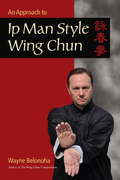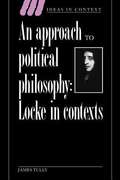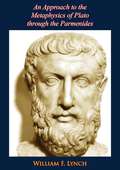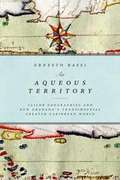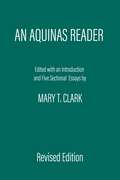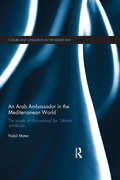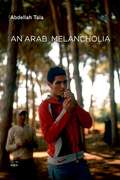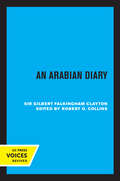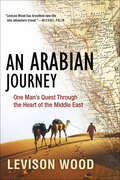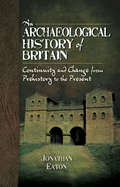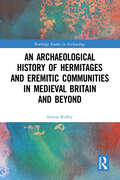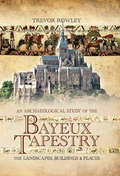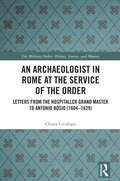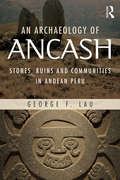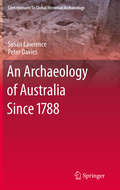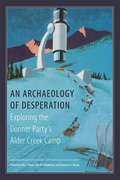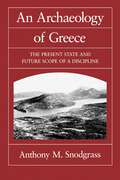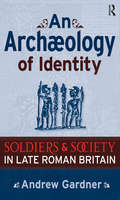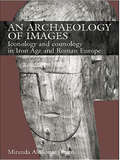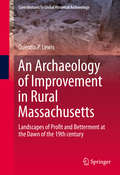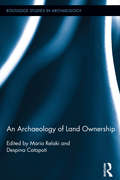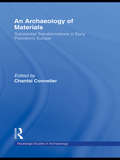- Table View
- List View
An Approach to Ip Man Style Wing Chun
by Wayne BelonohaAn Approach to Ip Man Style Wing Chun is a practical new beginner's guide to Wing Chun by a certified instructor in the Ip Man lineage. Pan American Triple Gold Medalist Wayne Belonoha provides the fundamentals of the art as a comprehensive mind/body training program. Written in accessible language and including more than 400 full-color photos, the book emphasizes benefits including weight reduction, stress management, personal defense and safety, and self-discipline through meditation.From the Trade Paperback edition.
An Approach to Long-Term Fiscal Policy Analysis
by Steven Dunaway Papa N'DiayeA report from the International Monetary Fund.
An Approach to Political Philosophy: Locke in Contexts
by James TullyAn Approach to Political Philosophy: Locke in Contexts brings together Professor Tully's most important and innovative statements on Locke in a systematic treatment of the latter's thought that is at once contextual and critical. <P><P>Each essay has been rewritten and expanded for this volume, and each seeks to understand a theme of Locke's political philosophy by interpreting it in light of the complex contexts of early modern European political thought and practice. <P>These historical studies are then used in a variety of ways to gain critical perspectives on the assumptions underlying current debates in political philosophy and the history of political thought. The themes treated include government, toleration, discipline, property, aboriginal rights, individualism, power, labor, self-ownership, community, progress, liberty, participation, and revolution.<P>Major general statement on Locke by one of world's leading authorities.<P> Topics discussed still at centre of political debates today.<P> Excellent upper-level adoption potential.
An Approach to the Metaphysics of Plato through the Parmenides
by William F. LynchA provocative and original interpretation of the Parmenides as constructive, positive metaphysics. By bringing together the speculative enthusiasm of the continental tradition with the more patient analysis of English scholarship Lynch has opened up a new line of inquiry and discussion.--R. S. B.in Review of Review of Metaphysics 13
An Aqueous Territory: Sailor Geographies and New Granada's Transimperial Greater Caribbean World
by Ernesto BassiIn An Aqueous Territory Ernesto Bassi traces the configuration of a geographic space he calls the transimperial Greater Caribbean between 1760 and 1860. Focusing on the Caribbean coast of New Granada (present-day Colombia), Bassi shows that the region's residents did not live their lives bounded by geopolitical borders. Rather, the cross-border activities of sailors, traders, revolutionaries, indigenous peoples, and others reflected their perceptions of the Caribbean as a transimperial space where trade, information, and people circulated, both conforming to and in defiance of imperial regulations. Bassi demonstrates that the islands, continental coasts, and open waters of the transimperial Greater Caribbean constituted a space that was simultaneously Spanish, British, French, Dutch, Danish, Anglo-American, African, and indigenous. Exploring the "lived geographies" of the region's dwellers, Bassi challenges preconceived notions of the existence of discrete imperial spheres and the inevitable emergence of independent nation-states while providing insights into how people envision their own futures and make sense of their place in the world.
An Aquinas Reader: Selections from the Writings of Thomas Aquinas
by Mary T. ClarkAvailable in a new digital edition with reflowable text suitable for e-readersThis new edition of An Aquinas Reader contains in one closely knit volume representative selections that reflect every aspect of Aquinas’s philosophy. Divided into three section – Reality, God, and Man – this anthology offers an unrivaled perspective of the full scope and rich variety of Aquinas’s thought. It provides the general reader with an overall survey of one of the most outstanding thinks or all time and reveals the major influence he has had on many of the world’s greatest thinkers. This revised third edition of Clark’s perennial still has all of the exceptional qualities that made An Aquinas Reader a classic, but contains a new introduction, improved format, and an updated bibliography.
An Arab Ambassador in the Mediterranean World: The Travels of Muhammad ibn ‘Uthmān al-Miknāsī, 1779-1788 (Culture and Civilization in the Middle East)
by Nabil MatarThis book provides translated selections from the writings of Muhammad Ibn Othman al-Miknasi (d. 1799). The only writings by an Arab-Muslim in the pre-modern period that present a comparative perspective, his travelogues provide unique insight with in to Christendom and Islam. Translating excerpts from his three travelogues, this book tells the story of al-Miknasi’s travels from 1779-1788. As an ambassador, al-Miknasi was privy to court life, government offices and religious buildings, and he provides detailed accounts of cities, people, customs, ransom negotiations, historical events and political institutions. Including descriptions of Europeans, Arabs, Turks, Christians (both European and Eastern), Muslims, Jews, and (American) Indians in the last quarter of the eighteenth century, An Arab Ambassador in the Mediterranean World explores how the most travelled Muslim writer of the pre-modern period saw the world: from Spain to Arabia and from Morocco to Turkey, with second-hand information about the New World. Supplemented with extensive notes detailing the historic and political relevance of the translations, this book is of interest to researchers and scholars of Mediterranean History, Ottoman Studies and Muslim-Christian relations.
An Arab Melancholia
by Abdellah Taïa Frank StockAn autobiographical portrait of a gay Arab man, living between cultures, seeking an identity through love and writing. Near Rabat. The mid 1980s. A lower-class teenager is running until he's out of breath. He's running after his dream, his dream to become a movie director. He's running after the Egyptian movie star, Souad Hosni, who's out there somewhere, miles away from this neighborhood--which is a place the teenager both loves and hates, the home at which he is not at home, an environment that will only allow him his identity through the cultural lens of shame and silence. Running is the only way he can stand up to the violence that is his Morocco. Irresistibly charming, angry, and wry, this autobiographical novel traces the emergence of Abdellah Taia's identity as an openly gay Arab man living between cultures. The book spans twenty years, moving from Sale to Paris, to Cairo. Part incantation, part polemic, and part love letter, this extraordinary novel creates a new world where the self is effaced by desire and love, and writing is always an act of discovery.
An Arabian Diary
by Sir Gilbert ClyatonThis personal diary of six months of diplomacy and travel in Arabia represents and impressive document to the quiet ability and resourcefulness of one of Great Britain's leading officials in the Middle East in the 1920's. The sudden expansion of the Arabian Sultanate of Najd under the leadership of 'Abd-al-'Aziz ibn Sa'ud after the First World War presented a clear danger to British interests in the Middle East and threatened the strategically important Arabian corridor to India. To resolve this project the British government selected Sir Gilbert Clayton as their envoy to negotiate a settlement of differences and to determine the frontier between Saudi Arabia and the British Mandates of Trans-Jordan and Iraq. Sir Gilbert Falkingham Clayton (1875-1929) was a quiet, able soldier, administrator, and diplomat who had come out to eh Middle East during the reconquest of the Sudan and remained as a political officer in theSudan service, secretary to the Governor-General of the Sudan, Sir Reginald Wingate, and finally the Sudan agent at Cairo. At the outbreak of the First World War, Clayton served as the director of Military Intelligence an forged that remarkable intelligence team which included among others Leonard Woolley, George Lloyd, and T.E. Lawrence. Experience and resourceful, Clayton was an obvious choice to travel to the tents of Iban Sa'ud where the autumn of 1925 he negotiated the Bahra and Hadda Agreements fixing the frontiers of Saudi Arabia with Trans-Jordan and Iraq and cementing friendship between Britain and Ibn Sa'ud. These results represent a brilliant triumph of personal diplomacy which protected British interests and inaugurated the lifelong friendship between Sir Gilbert and Ibn Sa'ud. The story of these negotiations and Sir Gilbert's subsequent mission to the Imam of Yemen as the first official representative of the British government to visit San'a' are told in this valuable historical diary. This title is part of UC Press's Voices Revived program, which commemorates University of California Press's mission to seek out and cultivate the brightest minds and give them voice, reach, and impact. Drawing on a backlist dating to 1893, Voices Revived makes high-quality, peer-reviewed scholarship accessible once again using print-on-demand technology. This title was originally published in 1969.
An Arabian Journey: One Man's Quest Through the Heart of the Middle East
by Levison WoodThe acclaimed author of Walking the Americas shares his epic journey through the war-torn Arabian Peninsula in this fascinating travelogue.Following in the footsteps of famed explorers such as Lawrence of Arabia and Wilfred Thesiger, British explorer Levison Wood brings us along on his most complex expedition yet: a circumnavigation of the Arabian Peninsula. Starting in September 2017 in a city in Northern Syria, a stone’s throw away from Turkey and amidst a deadly war, Wood set forth on a 5,000-mile trek through the most contested region on the planet.Wood moved through the Middle East for six months, from ISIS-occupied Iraq through Kuwait and along the jagged coastlines of the Emirates and Oman; across Yemen—in the midst of civil war—and on to Saudia Arabia, Jordan, and Israel, before ending on the shores of the Mediterranean in Lebanon. Like his predecessors, Wood travelled through some of the harshest and most beautiful environments on earth, seeking to challenge our perceptions of this part of the world. Through the people he meets—and the personal histories and local mythologies they share—Wood examines how the region has changed over thousands of years and what it means to its people today.
An Archaeological History of Britain: Continuity and Change from Prehistory to the Present
by Jonathan EatonThis authoritative and accessible volume presents an archeological of Britain across millennia, from early prehistory to the present. The Archaeological History of Britain takes us from the earliest prehistoric archaeology right up to the contemporary archaeology of the present day through the use of key sites. Historian Jonathan Eaton uses key sites to illustrate each significant time period along with a narrative of change to accompany the changing archaeological record. The wide range of evidence utilized by archaeologists, such as artefacts, landscape studies, historical sources and genetics are emphasized throughout this chronological journey. The latest theoretical advances and practical discoveries are also explored, making this the most advanced narrative of British archaeology available.
An Archaeological History of Hermitages and Eremitic Communities in Medieval Britain and Beyond (Routledge Studies in Archaeology)
by Simon RoffeyMany hermitages and eremitic communities are recorded throughout the medieval period, yet to date, there has been no comprehensive archaeological study. This richly illustrated book will consequently discuss a range of hermitages and introduce the reader to their architectural forms, spaces, location and environments as well as the religious practices associated with them. It will focus primarily on the British material but will nonetheless consider this within a wider comparative framework. Overall, it will offer an archaeological history of hermitages and presents a unique window into a lost world of medieval spirituality and religious life. Key related themes will include the earliest archaeological evidence for hermits (eremitic life) in India, China and East Asia, pre- and early Christian desert hermitages, cave hermitages, eremitic communities, saints and missionary hermits, life and diet, medieval mysticism and the contemplative tradition, secular and ornamental hermitages and hermits in post-medieval and contemporary society. This book offers an illustrated archaeological history of hermitages and eremitic communities, with reference to key examples and case studies. It will therefore appeal to both academics, students and a more general readership interested in archaeology, history, comparative religion, architecture, religion and belief, spirituality, medieval Britain, modern contemplative practice and contemporary heritage issues.
An Archaeological Study of the Bayeux Tapestry: The Landscapes, Buildings and Places
by Trevor RowleyAn analysis of the famed medieval English tapestry through examination of the depicted landscapes, towns, castles, and other structures.An Archaeological Study of the Bayeux Tapestry provides a unique re-examination of this famous piece of work through the historical geography and archaeology of the tapestry. Trevor Rowley is the first author to have analyzed the tapestry through the landscapes, buildings and structures shown, such as towns and castles, while comparing them to the landscapes, buildings, ruins and earthworks which can be seen today. By comparing illustrated extracts from the tapestry to historical and contemporary illustrations, maps and reconstructions Rowley is able to provide the reader with a unique visual setting against which they are able to place the events on the tapestry. This approach allows Rowley to challenge a number of generally accepted assumptions regarding the location of several scenes in the tapestry, most controversially suggesting that William may never have gone to Hastings at all. Finally, Rowley tackles the missing end of the tapestry, suggesting the places and events which would have been depicted on this portion of William&’s journey to Westminster.Praise forAn Archaeological Study of the Bayeux Tapestry &“We all know what the Bayeux Tapestry celebrates in its iconic artwork, but Trevor Rowley goes one step further and looks at the buildings and characters with a view actually identifying them! Absolutely fascinating, brings a whole new dimension to the study of this amazing artefact.&” —Books Monthly &“Rowley&’s arguments are copiously illustrated with details from the tapestry, photographs and plans. It results in very densely packed chapters well worth reading, and you certainly will never look at that tea towel in the same way again.&” —Hexham Local History Society
An Archaeologist in Rome at the Service of the Order: Letters from the Hospitaller Grand Master to Antonio Bosio (1604–1629) (The Military Religious Orders)
by Chiara CecalupoAn Archaeologist in Rome at the Service of the Order presents the so-far completely unknown letters between the Grand Masters (Alof de Wignacourt, Luís Mendes de Vasconcellos and Antoine de Paule) and Antonio Bosio, who is well known worldwide for his extensive discoveries of the Roman Christian catacombs and was also an Agent of the Order of Malta in Rome. The letters were sent between 1604 and 1629 and are currently held at the National Library of Malta.After a complete account on Bosio’s biography and family history, the letters are transcribed, translated and commented, in order to open a window on the role of the Agent in Rome in the very early seventeenth century, a particular juncture in the Order’s history, and on the relations between Malta and Rome.The study and publication of these materials make it possible to present Antonio Bosio’s political and administrative works at the service of the Grand Master to the international public and academics interested in the history of the Order.
An Archaeology of Ancash: Stones, Ruins and Communities in Andean Peru
by George LauAn Archaeology of Ancash is a well–illustrated synthesis of the archaeology of North Central Peru, and specifically the stone structures of the Ancash region. All the major cultures of highland Ancash built impressive monuments, with no other region of South America showing such an early and continuous commitment to stone carving. Drawing on Lau’s extensive experience as an archaeologist in highland Peru, this book reveals how ancient groups of the Central Andes have used stone as both a physical and symbolic resource, uncovering the variety of experiences and meanings which marked the region’s special engagement with this material. An abundant raw resource in the Andes, stone was used for monuments, sculptures and other valuables such as carved monoliths, which were crucial to the emergence of civilization in the region, and religious objects from magical charms to ancestor effigies. Detailing the ways stone has played both an everyday and an extraordinary part in ancient social life, Lau also examines how cultural dispositions towards this fundamental material have changed over time and considers how contemporary engagements with these stone remains have the potential to create and regenerate communities. With an ample selection of color photos which bring these sites and artifacts to life, An Archaeology of Ancash is an essential guide to the key monuments, places and objects that distinguish this region and its rich archaeological heritage.
An Archaeology of Architecture: Photowriting the Built Environment
by Dennis TedlockPage by page, this book takes us on a journey through the built world that ranges from Greece to Guatemala and from New York to San Francisco. Tedlock practices what he calls photowriting, a creative process that brings photographer and writer together in the same person. It may be true enough that a photograph can show more than words can say, but it is equally true that words can say more than a photograph can show. A third space opens up in the middle, where the viewer reader can look back and forth between image and text at will.Tedlock looks at the built world with the eye of an archaeologist and ethnographer His long experience as a fieldworker has made him acutely aware of the ways in which buildings are continuously altered by human actions and natural forces Anthropology assigns ruins to archaeology and structures currently in use to ethnology, but Tedlock reminds the viewer that an occupied building bears marks of the same processes that produce archaeological remains. As he puts it, &“Whenever I look around at the worlds humans build for themselves, I see archaeology in the making.&”
An Archaeology of Australia Since 1788 (Contributions To Global Historical Archaeology)
by Peter Davies Susan LawrenceThis volume provides an important new synthesis of archaeological work carried out in Australia on the post-contact period. It draws on dozens of case studies from a wide geographical and temporal span to explore the daily life of Australians in settings such as convict stations, goldfields, whalers' camps, farms, pastoral estates and urban neighbourhoods. The different conditions experienced by various groups of people are described in detail, including rich and poor, convicts and their superiors, Aboriginal people, women, children, and migrant groups. The social themes of gender, class, ethnicity, status and identity inform every chapter, demonstrating that these are vital parts of human experience, and cannot be separated from archaeologies of industry, urbanization and culture contact. The book engages with a wide range of contemporary discussions and debates within Australian history and the international discipline of historical archaeology. The colonization of Australia was part of the international expansion of European hegemony in the eighteenth and nineteenth century. The material discussed here is thus fundamentally part of the global processes of colonization and the creation of settler societies, the industrial revolution, the development of mass consumer culture, and the emergence of national identities. Drawing out these themes and integrating them with the analysis of archaeological materials highlights the vital relevance of archaeology in modern society.
An Archaeology of Desperation: Exploring The Donner Party's Alder Creek Camp
by Julie M. Schablitsky Kelly J. Dixon Shannon A. NovakThe Donner Party is almost inextricably linked with cannibalism. In truth, we know remarkably little about what actually happened to the starving travelers stranded in the Sierra Nevada in the winter of 1846-47. Combining the approaches of history, ethnohistory, archaeology, bioarchaeology, and social anthropology, this innovative look at the Donner Party's experience at the Alder Creek Camp offers insights into many long-unsolved mysteries. Centered on archaeological investigations in the summers of 2003 and 2004 near Truckee, California, the book includes detailed analyses of artifacts and bones that suggest what life was like in this survival camp. Microscopic investigations of tiny bone fragments reveal butchery scars and microstructure that illuminate what the Donner families may have eaten before the final days of desperation, how they prepared what served as food, and whether they actually butchered and ate their deceased companions. The contributors reassess old data with new analytic techniques and, by examining both physical evidence and oral testimony from observers and survivors, add new dimensions to the historical narrative. The authors' integration of a variety of approaches - including narratives of the Washoe Indians who observed the Donner Party - destroys some myths, deconstructs much of the folklore about the stranded party, and demonstrates that novel approaches can shed new light on events we thought we understood.
An Archaeology of Educational Evaluation: Epistemological Spaces and Political Paradoxes
by Emiliano GrimaldiAn Archaeology of Educational Evaluation: Epistemological Spaces and Political Paradoxes outlines the epistemology of the theories and models that are currently employed to evaluate educational systems, education policy, educational professionals and students learning. It discusses how those theories and models find their epistemological conditions of possibility in a specific set of conceptual transferences from mathematics and statistics, political economy, biology and the study of language. The book critically engages with the epistemic dimension of contemporary educational evaluation and is of theoretical and methodological interest. It uses Foucauldian archaeology as a problematising method of inquiry within the wider framework of governmentality studies. It goes beyond a mere critique of the contemporary obsession for evaluation and attempts to replace it with the opening of a free space where the search for a mode of being, acting and thinking in education is not over-determined by the tyranny of improvement. This book will appeal to academics, researchers and postgraduate students in the fields of educational philosophy, education policy and social science.
An Archaeology of Greece: The Present State and Future Scope of a Discipline (Sather Classical Lectures #53)
by Anthony M. SnodgrassClassical archaeology probably enjoys a wider appeal than any other branch of classical or archaeological studies. As an intellectual and academic discipline, however, its esteem has not matched its popularity. Here, Anthony Snodgrass argues that classical archaeology has a rare potential in the whole field of the study of the past to make innovative discoveries and apply modern approaches by widening the aims of the discipline.
An Archaeology of Identity: Soldiers and Society in Late Roman Britain (UCL Institute of Archaeology Publications)
by Andrew GardnerWhat happened to Roman soldiers in Britain during the decline of the empire in the 4th and 5th centuries? Did they withdraw, defect, or go native? More than a question of military history, this is the starting point for Andrew Gardner’s incisive exploration of social identity in Roman Britain, in the Roman Empire, and in ancient society. Drawing on the sociological theories of Anthony Giddens and others, Gardner shapes an approach that focuses on the central role of practice in the creation and maintenance of identities—nationalist, gendered, class, and ethnic. This theory is then tested against the material remains of Roman soldiers in Britain to show how patterning of stratigraphy, architecture, and artifacts supports his theoretical construct. The result is a retelling of the story of late Roman Britain sharply at odds with the traditional text-driven histories and a theory of human action that offers much to current debates across the social sciences.
An Archaeology of Images: Iconology and Cosmology in Iron Age and Roman Europe
by Miranda Aldhouse GreenUsing archaeology and social anthropology, and more than 100 original line drawings and photographs, An Archaeology of Images takes a fresh look at how ancient images of both people and animals were used in the Iron Age and Roman societies of Europe, 600 BC to AD 400 and investigates the various meanings with which images may have been imbued. The book challenges the usual interpretation of statues, reliefs and figurines as passive things to be looked at or worshipped, and reveals them instead as active artefacts designed to be used, handled and broken. It is made clear that the placing of images in temples or graves may not have been the only episode in their biographies, and a single image may have gone through several existences before its working life was over. Miranda Aldhouse Green examines a wide range of other issues, from gender and identity to foreignness, enmity and captivity, as well as the significance of the materials used to make the images. The result is a comprehensive survey of the multifarious functions and experiences of images in the communities that produced and consumed them. Challenging many previously held assumptions about the meaning and significance of Celtic and Roman art, An Archaeology of Images will be controversial yet essential reading for anyone interested in this area.
An Archaeology of Improvement in Rural Massachusetts: Landscapes of Profit and Betterment at the Dawn of the 19th century (Contributions To Global Historical Archaeology)
by Quentin LewisThis book probes the materiality of Improvement in early 19th century rural Massachusetts. Improvement was a metaphor for human intervention in the dramatic changes taking place to the English speaking world in the 18th and 19th centuries as part of a transition to industrial capitalism. The meaning of Improvement vacillated between ideas of economic profit and human betterment, but in practice, Improvement relied on a broad assemblage of material things and spaces for coherence and enaction. Utilizing archaeological data from the home of a wealthy farmer in rural Western Massachusetts, as well as an analysis of early Republican agricultural publications, this book shows how Improvement's twin meanings of profit and betterment unfolded unevenly across early 19th century New England. The Improvement movement in Massachusetts emerged at a time of great social instability, and served to ameliorate growing tensions between urban and rural socioeconomic life through a rationalization of space. Alongside this rationalization, Improvement also served to reshape rural landscapes in keeping with the social and economic processes of a modernizing global capitalism. But the contradictions inherent in such processes spurred and buttressed wealth inequality, ecological distress, and social dislocation.
An Archaeology of Land Ownership (Routledge Studies in Archaeology #9)
by Maria Relaki Despina CatapotiWithin archaeological studies, land tenure has been mainly studied from the viewpoint of ownership. A host of studies has argued about land ownership on the basis of the simple co-existence of artefacts on the landscape; other studies have tended to extrapolate land ownership from more indirect means. Particularly noteworthy is the tendency to portray land ownership as the driving force behind the emergence of social complexity, a primordial ingredient in the processes that led to the political and economic expansion of prehistoric societies. The association between people and land in all of these interpretive schemata is however less easy to detect analytically. Although various rubrics have been employed to identify such a connection – most notable among them the concepts of ‘cultures,’ ‘regions,’ or even ‘households’ – they take the links between land and people as a given and not as something that needs to be conceptually defined and empirically substantiated. An Archaeology of Land Ownership demonstrates that the relationship between people and land in the past is first and foremost an analytical issue, and one that calls for clarification not only at the level of definition, but also methodological applicability. Bringing together an international roster of specialists, the essays in this volume call attention to the processes by which links to land are established, the various forms that such links take and how they can change through time, as well as their importance in helping to forge or dilute an understanding of community at various circumstances.
An Archaeology of Materials: Substantial Transformations in Early Prehistoric Europe (Routledge Studies in Archaeology)
by Chantal ConnellerAn Archaeology of Materials sets out a new approach to the study of raw materials. Traditional understandings of materials in archaeology (and in western thought more widely) have failed to acknowledge both the complexity and, moreover, the benefits of an analysis of materials. Here Conneller argues that materials cannot be understood independently of the practices through which they are constituted. Drawing on a number of different thinkers, and using case studies from the European early Prehistoric period, she investigates how we can rethink the properties of matter and the relationship of material and form. What emerges from this book is the variability and the specificity of human-material interactions and the rather more active role that matter plays in these than traditionally conceived. Rather than being insignificant, a formless substrate or simply a constraint to human action, it is argued that materials are more fundamental. Tracing the processes by which the properties of past materials emerge reveals the working of past worlds, particularly articulations of the cultural, the natural and the supernatural. This book will establish a new perspective on the meaning and significance of materials, particularly those involved in mundane, daily usage, and will be a timely addition to the literature on technologies and materials.
